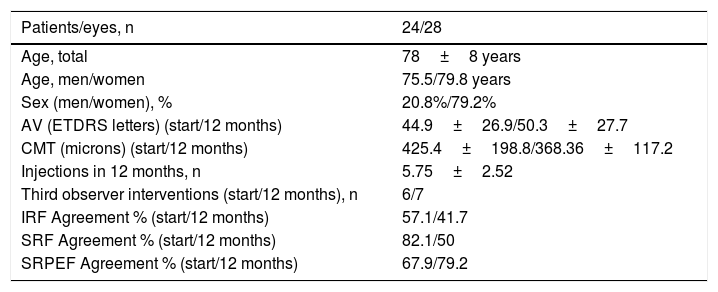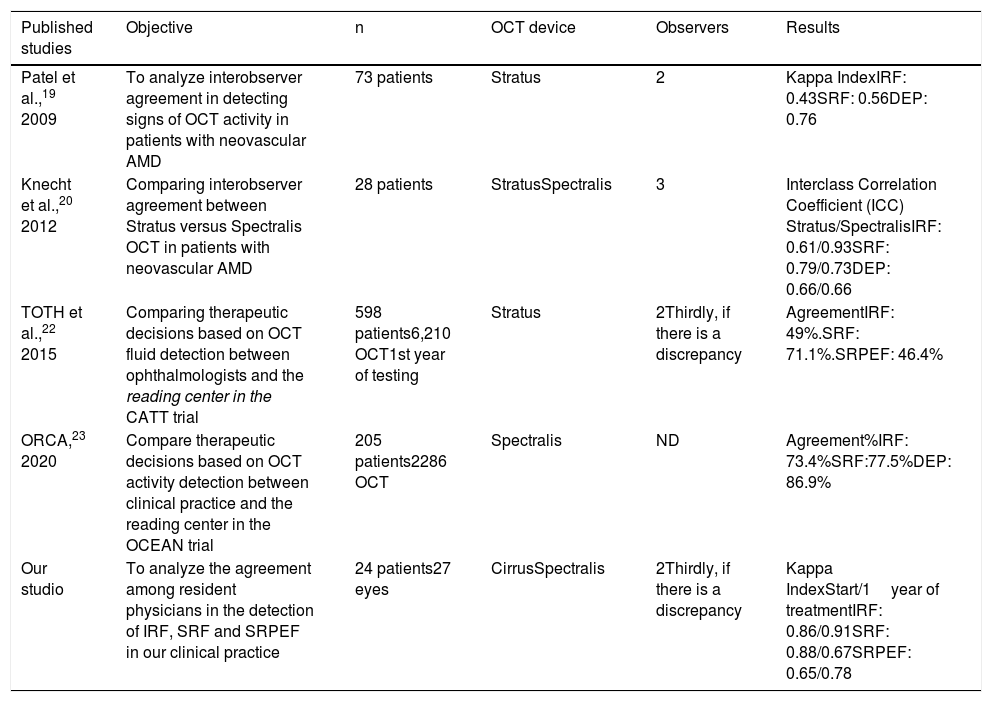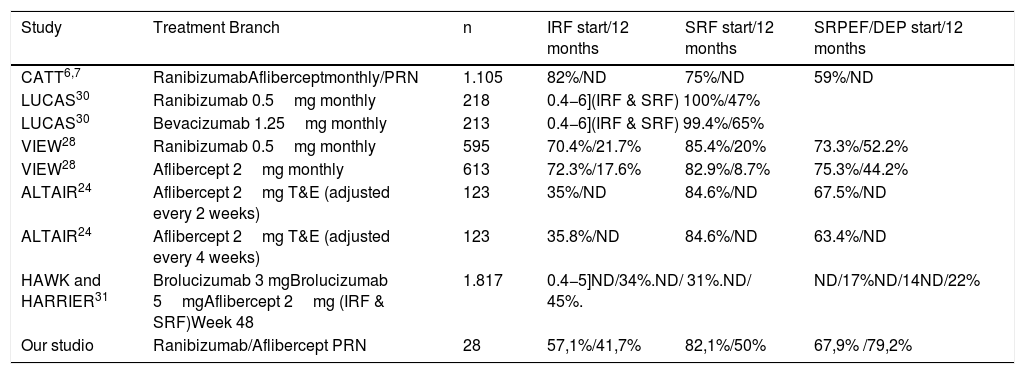To analyze the presence of subretinal fluid (SRF), intraretinal fluid (IRF) and subretinal pigment epithelial fluid (SRPEF) in näive patients with exudative neovascular AMD at baseline and at one year follow-up and treatment, in clinical practice, and perform a concordance analysis between resident physicians.
MethodsA retrospective analysis of the näive patients who attended our service for 6 months between 2016–2017 by neovascular AMD was performed. Optical coherence tomography (OCT), at baseline and at one year follow-up, were analyzed from independently by two resident doctors, determined the presence or not of SRF, IRF, SRPEF. A retina specialist ophthalmologist intervened in cases where there was no consensus among resident physicians. A descriptive and interobserver concordance analysis was performed.
Results27 eyes of 24 patients were evaluated, 20.8% being men and 79.16% women, with a mean age of 78.57±8 years. 32.14% of the eyes presented the three types of fluid before the start of treatment and the frequency of the different fluids at the beginning and at the end of the follow-up were respectively: SRF, 82.1% and 50%; IRF, 57.1% and 41.7%, and SRPEF, 67.9% and 79.2%). The Kappa analysis of interobserver concordance in the evaluation of the different fluids at the beginning and at the end of the follow-up were respectively: SRF, 0.88 and 0.67; IRF, 0.86 and 0.91, and SRPEF, 0.65 and 0.78.
ConclusionsThe presence of SRF, IRF, RPEF in clinical practice, in the debut of neovascular AMD has a similar distribution to that presented in international clinical trials. The agreement between resident physicians is very good for SRF and IRF and good for SRPEF in the debut of the disease and good for SRF and IRF and very good for SRPEF at one year of treatment.
Describir la presencia de fluido subretiniano (FSR), fluido intrarretiniano (FIR) y fluido sub-epitelio pigmentario de la retina (FSEPR) en pacientes näive con degeneración macular asociada a la edad (DMAE) neovascular exudativa en el momento basal y al año de seguimiento y tratamiento, en nuestra práctica clínica, y realizar un análisis de concordancia entre médicos residentes.
MétodosSe realizó un análisis retrospectivo de los pacientes näive que acudieron a nuestro servicio durante 6 meses, entre 2016 y 2017, por DMAE neovascular. Las tomografías de coherencia óptica (OCT), del momento basal y al año de seguimiento, fueron analizadas de forma independiente por dos médicos residentes, determinando la presencia o no de FSR, FIR y FSEPR. Un oftalmólogo especialista en retina intervino en los casos en que no hubo consenso entre los médicos residentes. Se realizó un análisis descriptivo y de concordancia interobservador.
ResultadosSe evaluaron 28 ojos de 24 pacientes, siendo el 20,8% hombres y el 79,16% mujeres, con una edad media de 78,57±8 años. El 32,14% de los ojos presentaron los tres tipos de fluido antes del inicio del tratamiento. La frecuencia de los diferentes fluidos en el inicio y al final del seguimiento fueron, respectivamente: FSR, 82,1 y 50%; FIR, 57,1 y 41,7%, y FSEPR, 67,9 y 79,2%. El análisis kappa de concordancias interobservador en la evaluación de los diferentes fluidos en el inicio y al final del seguimiento fueron, respectivamente: FSR, 0,88 y 0,67; FIR, 0,86 y 0,91, y FSEPR, 0,65 y 0,78.
ConclusionesLa presencia de FSR, FIR y FSEPR en práctica clínica en el debut de la DMAE neovascular tiene una distribución similar a la presentada en ensayos clínicos internacionales. La concordancia entre médicos residentes es muy buena para el FSR y FIR y buena para el FSEPR en el debut de la enfermedad y buena para el FSR y FIR y muy buena para el FSEPR al año de tratamiento.










